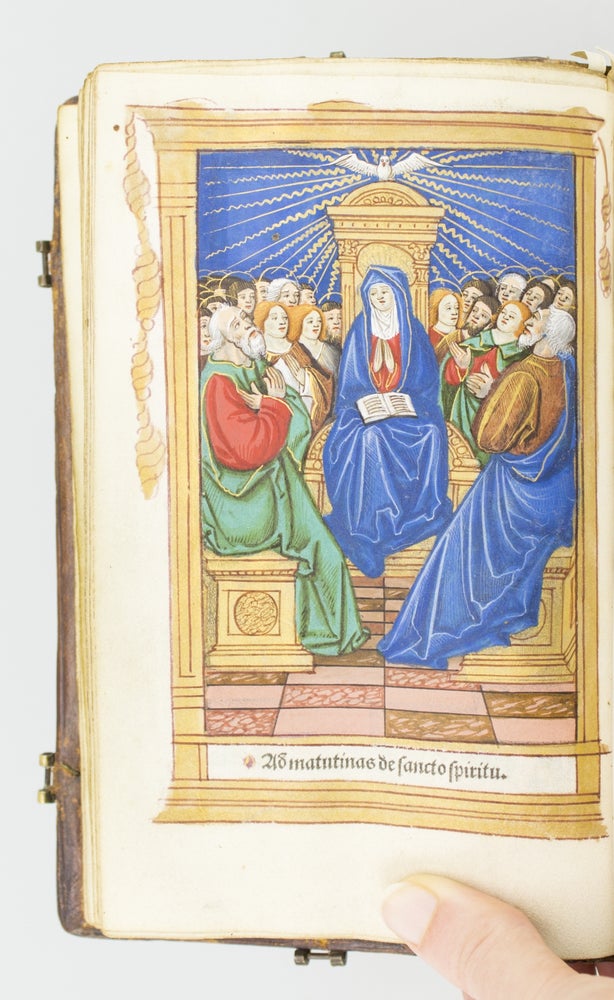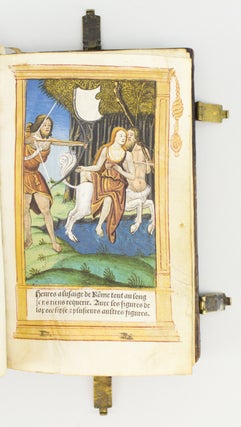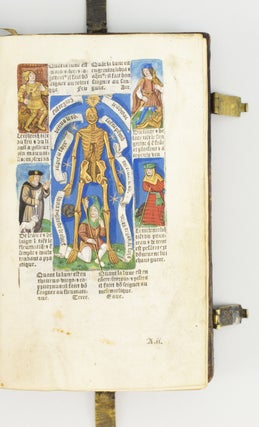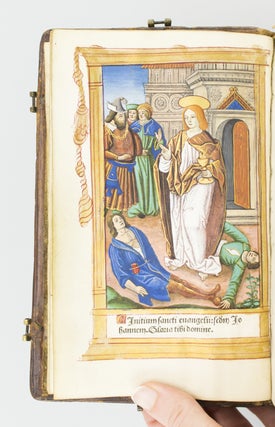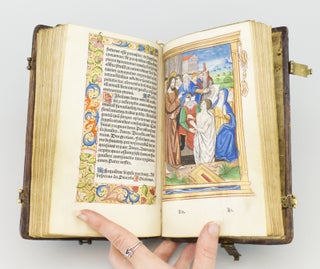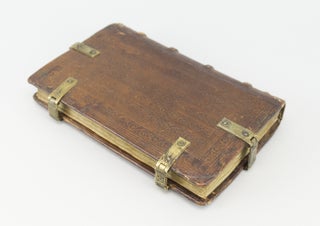A PRINTED BOOK OF HOURS ON VELLUM, IN LATIN AND FRENCH. USE OF ROME.
(Paris: Gillet Hardouin, 1516 [calendar covering the years 1516-27]). 197 x 120 mm. (7 3/4 x 4 1/2"). 104 leaves.
FINE CONTEMPORARY BLIND-TOOLED CALF, covers with multiple rules and floral rolls, raised bands, gilt lettering in two compartments, skillfully rebacked in the style of the period, four brass clasps and catch plates (possibly renewed), original vellum endleaves. In a vellum clamshell box. WITH 23 VIGNETTES AND 16 FULL-PAGE METAL CUTS within architectural borders, BEAUTIFULLY ILLUMINATED IN COLORS AND GOLD BY A CONTEMPORARY HAND. Front pastedown with engraved bookplate of "J. R. P.," rear endleaves with genealogical information in an early hand. The coloring of one of the vignettes left unfinished. ◆Extremities and raised bands with a little rubbing, minor (and very well done) repairs to a few places at the corners and edges, but the extremely attractive binding completely sound and pleasing. One miniature with faint creasing (mostly touching the robes of two figures), a few miniatures with insignificant paint erosion, the occasional marginal blemish, otherwise IN VERY FINE CONDITION THROUGHOUT, the text and decoration fresh, and the margins wide and very clean.
From its elaborately decorated binding to its finely executed and brightly painted scenes of the life of Christ and the Virgin to its intriguing provenance, the present volume provides several sources of pleasure. While the most famous examples of the private collections of prayers known as Books of Hours were manuscript versions commissioned by persons of great wealth, mostly during the 15th century, the popularity of what has been called the "Medieval bestseller" did not wane after the invention of printing. In fact, the advent of movable type made Books of Hours more affordable and widely available than ever. No matter the comparison with other examples, the present volume is distinctive in its beautiful and well-preserved contemporary coloring, which is uniformly rich throughout the volume. The painter was clearly a talented illuminator, with a high degree of sensitivity for color and detail. His deft use of shadow to create contours and to mold faces and musculature gives each scene a strong sense of vitality. The detail work in particular speaks to the quality of this production: one can distinguish the individual hairs on the hoary beard of David, tiny droplets of blood trickling down the body of Christ, and the carefully rendered facial expressions of most figures. The present work is not only a tantalizing reminder of the power of a good illuminator, but a particularly fortunate survival. Although the coat of arms on the title page remains unfinished, the numerous 16th and 17th century genealogical annotations on the rear endpapers, noting births, deaths, and marriages, tell us that it was in the possession of (and possibly commissioned by) the Mechtild family of Guelders (a duchy that occupied parts of present-day Netherlands and Germany). The unsoiled miniatures would suggest that this book was rarely opened, but it is equally possible that it was just handled with extraordinary care; in fact, the meticulous annotations suggest that it was treasured by the family that owned it, acting as both an object of devotion and a repository for the most important events of their collective lives. (ST13118)
Price: $32,000.00

